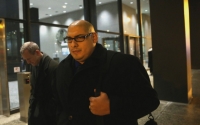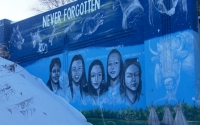For Northup of ‘12 Years a Slave,’ family determined to fulfill final wish


“I thought I knew who I was at a young age, I knew my history,” said Clayton J. Adams. “I knew my grandmother, but that’s as far back as I was able to go as far as my descendants.”
Then Adams learned that a much older ancestor had written an autobiography back in 1853. His great-great-great grandfather was Solomon Northup, a New York–born free black man who was kidnapped and sold into slavery in Louisiana. Those harrowing years were the subject of his memoir, “12 Years a Slave,” now an Oscar-nominated film.
“Reading this and realizing there is more to me than just two generations back — because it’s hard for African-Americans to trace their history because of the slave trade — to me it was a missing piece in my life, I didn't even know was missing,” Adams told America Tonight, clutching a first-edition copy of the book.
Northup’s autobiography served as a genealogical and historical roadmap for Adams. And this week, he retraced the steps of Northup’s final days as a free man. The millions of tourists who visit Washington every year don’t often realize that the nation’s capital was actually the center for the domestic slave trade in the 19th century. In fact, it was home to one of the most active slave depots in the country.
“This spot was the actual Gadsby’s Hotel where Solomon stayed at when he came down to Washington City,” Adams told America Tonight, standing outside the Newseum, the location of America Tonight’s studios. “This is also the place that he was kidnapped and brought down to the Williams slave pen to get sold into slavery. This was the last place where he was free. And this is my first time ever being in this spot in all of my travels in Washington city.”
The landmarks in his ancestor’s book have of course changed in 160 years, but Adams likes to stop at them and look around, taking in the view.
“The book is so detailed that I felt that I was there seeing through his eyes what he was going through with slavery,” he said. “Now I can see in his eyes what he was seeing before he was even kidnapped.”
After Northup was drugged at the hotel by two kidnappers, he woke up in shackles just a few blocks away at the Williams slave pen on 7th Street and Independence Avenue SW, where the Federal Aviation Administration headquarters sits today.
Northup wrote that he could see the U.S. Capitol from his captivity. Today, the Smithsonian’s National Air and Space Museum stands right in the way of the view he would have had.
“This definitely is the corner because he stated in his book that when he regained consciousness and looked out the cellar window of the William slave pen, he directly saw the U.S. Capitol,” Adams said, “and that's how he knew that he was still in Washington, D.C., and wasn't at least yet been sold down south to slavery.”

But just a few days later, Northup, along with other men who had been kidnapped, was taken to Louisiana, where he would endure the next 12 years as a slave.
“Solomon Northup's story is part of American history,” Adams said. “It is a history of America that has been swept under the rug for way too long. I am just making sure that his story is not just known to his family, but letting him know that we're getting your story out to the world because his story represents thousands of cases.” He added: “We are proud of Solomon Northup for his strength, his perseverance, his faith, his love for his family – and just letting him know that his story will be passed on a generation. I will ensure that my children know and they're going to make sure that their children know as well.”
Clayton J. Adams
Solomon Northup’s great-great-great-grandson
A final wish unfulfilled

Adams said it took him three tries to finish watching “12 Years a Slave.” When he read aloud the very last page from an original copy of Northup’s book, it became apparent why.
“My narrative is at an end. I have no comments to make upon the subject of slavery,” Adams read from the page, his eyes welling up. “Those who read this book may form their own opinions of the peculiar institution. What it may be in other states, I do not profess to know. What it is in the region of the Red River, is truly and faithfully delineated in these pages. This is no fiction. No exaggeration. I hope hence forward to lead an upright, though lowly, life. And rest at last in a churchyard where my father sleeps."
His tears made it hard for him to finish the passage.
While Adams tries his best to serve Northrup, his story and his legacy, there is one duty he’s unable to fulfill.
“So, in his book, his last request when he died was to lay right next to his father, which is a gravesite I have visited many a times, but unfortunately Solomon is not there,” he said. “His last request … hopefully, this movie will shed some light as to where he is now. Fifteen years of research, we still don't know. And if we can figure out where he is, (we can) transfer his body back to Baker’s Cemetery so that his final wish could come true.”
For more on “12 Years a Slave,” check out Adam Rothman’s opinion piece on what a Civil War’s soldier diary tells us about Solomon Northrup’s ordeal.












Error
Sorry, your comment was not saved due to a technical problem. Please try again later or using a different browser.